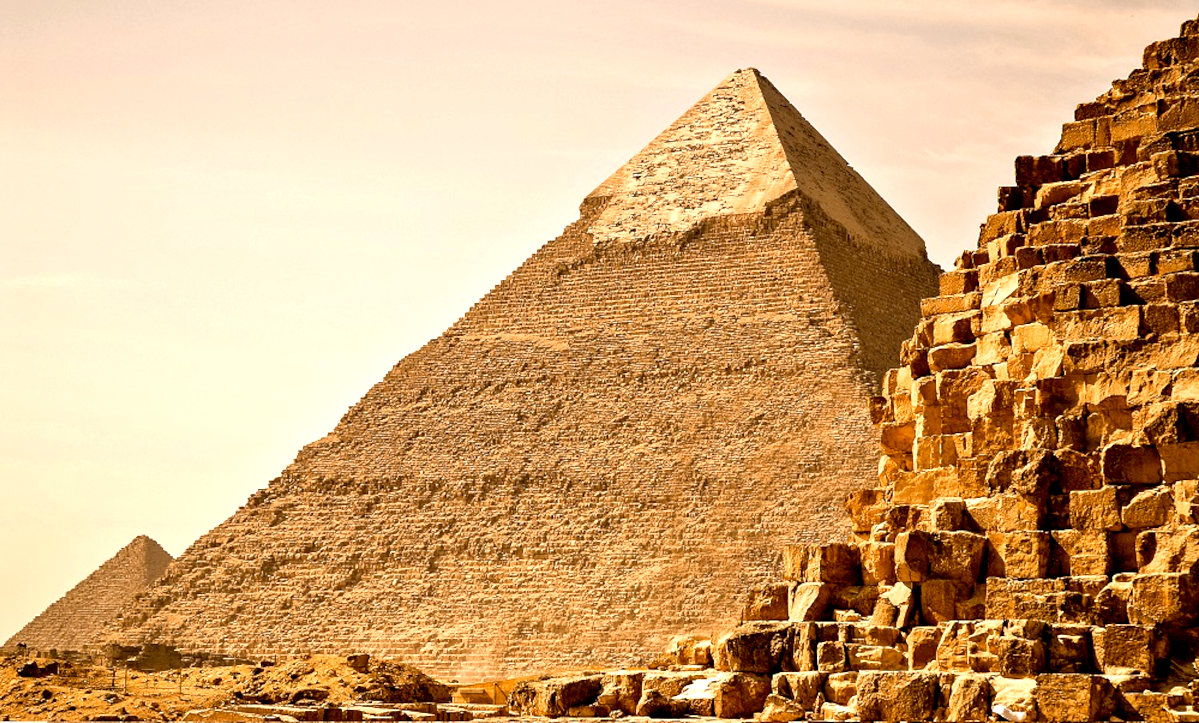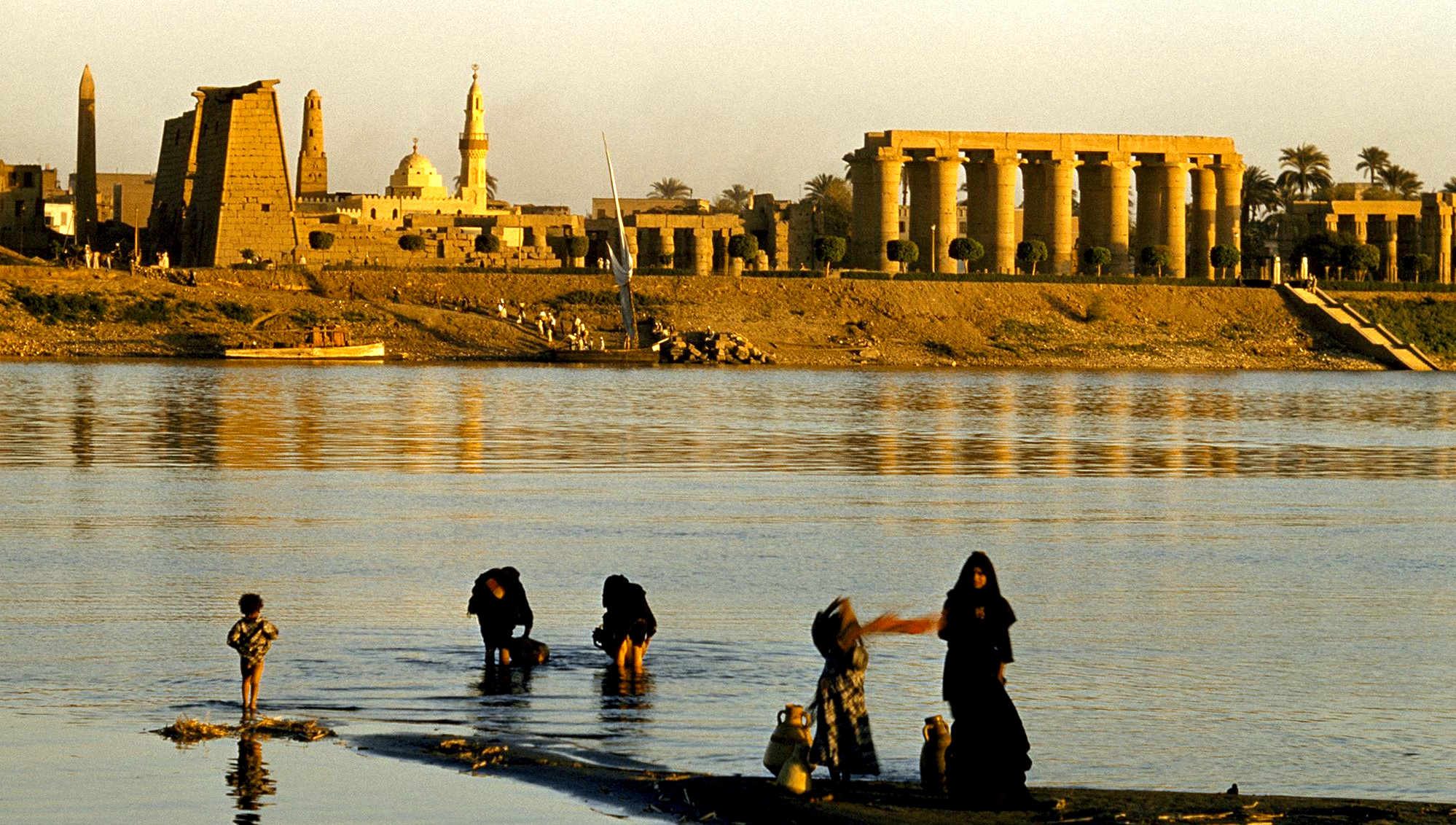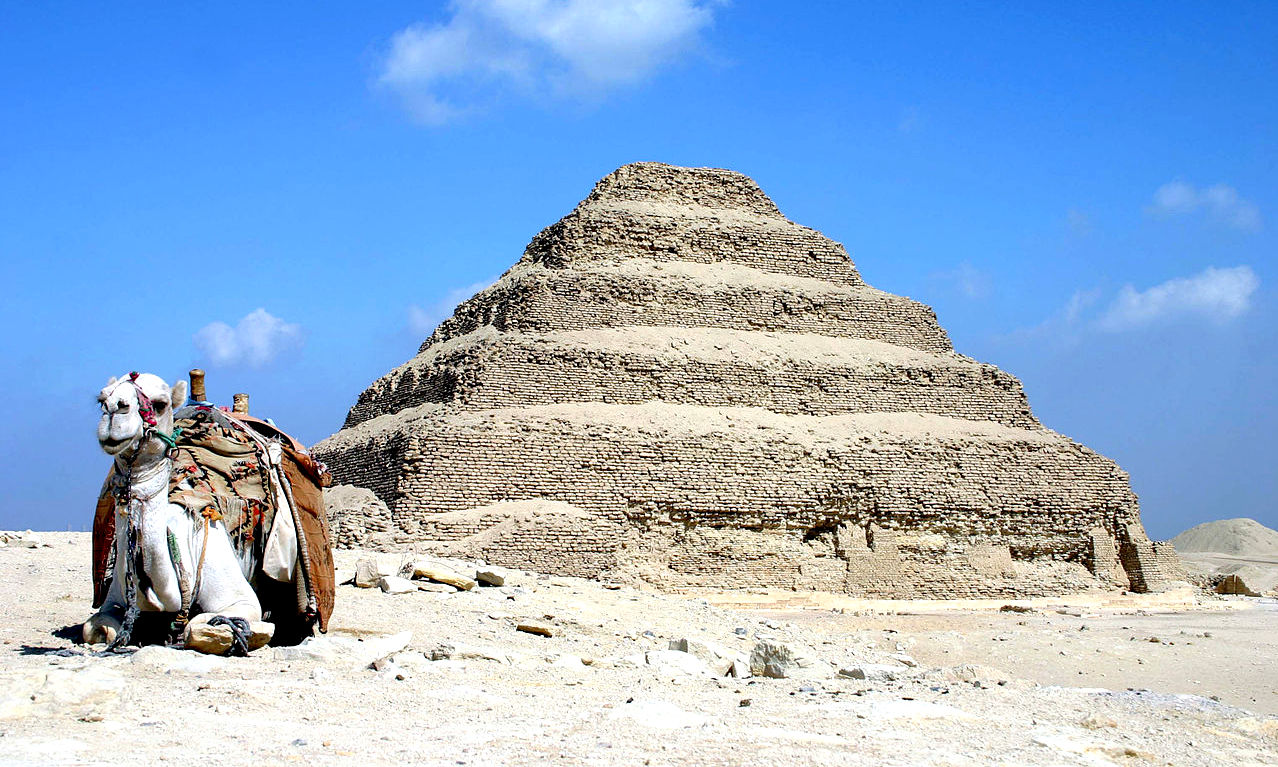
Saqqara
is the site of Djoser's (or Djeser and Zoser) Pyramid, the ninth tallest in
Egypt and the oldest surviving structure.
The Pyramid of Djoser, or Step Pyramid, is an archaeological site in the Saqqara necropolis, Egypt, northwest of the ruins of Memphis. The 6-tier, 4-sided structure is the earliest colossal stone building in Egypt. It was built in the 27th century BC during the Third Dynasty for the burial of Pharaoh Djoser. The pyramid is the central feature of a vast mortuary complex in an enormous courtyard surrounded by ceremonial structures and decoration. Its architect was Imhotep, chancellor of the pharaoh and high priest of the god
Ra.
The pyramid went through several revisions and redevelopments of the original plan. The pyramid originally stood 62.5 m (205 ft) tall, with a base of 109 m × 121 m (358 ft × 397 ft) and was clad in polished white limestone. The step pyramid (or proto-pyramid) was considered to be the earliest large-scale cut stone construction made by man as of 1997, although the nearby enclosure wall "Gisr el-Mudir" is suggested by some Egyptologists to predate the complex, and the South American pyramids at Caral are contemporary.
In March 2020, the pyramid was reopened for visitors after a 14-year restoration.
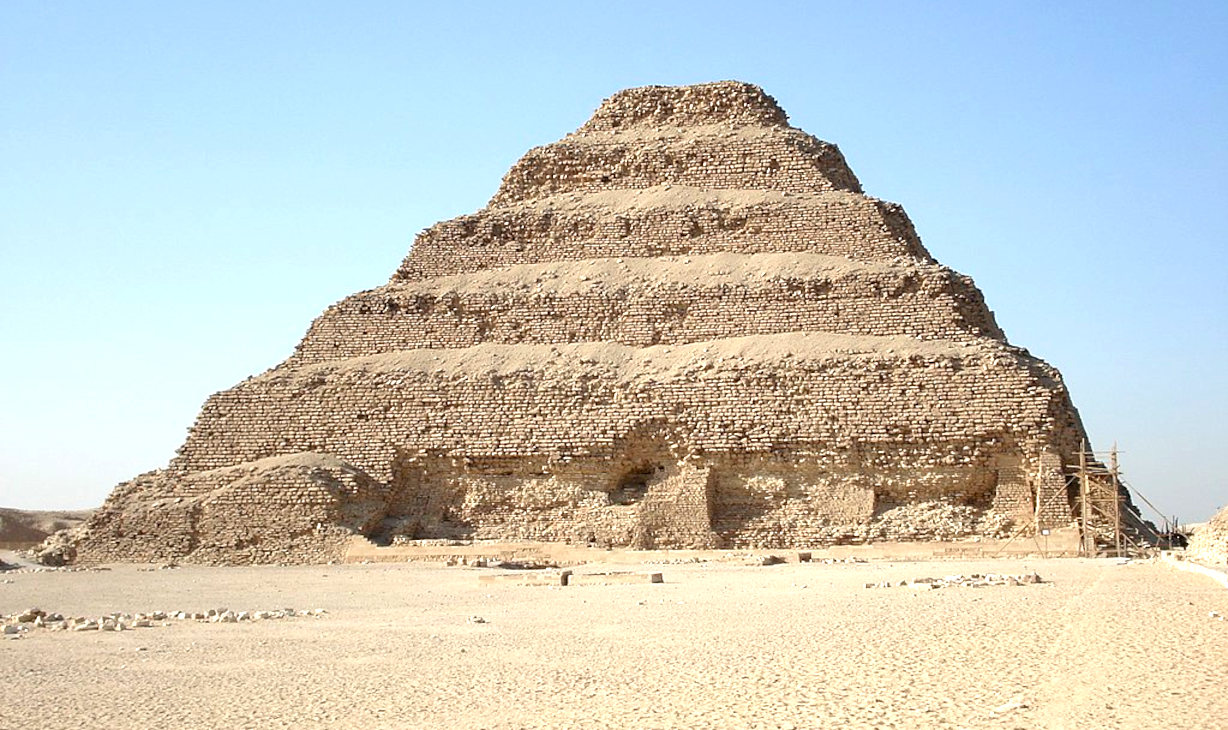
KING DJOSER
Djoser was the first or second king of the 3rd Dynasty (c. 2670–2650 BC) of the Egyptian Old Kingdom (c. 2686–2125 BC). He is believed to have ruled for 19 years or, if the 19 years were biennial taxation years, 38 years. He reigned long enough to allow the grandiose plan for his pyramid to be realized in his lifetime.
Djoser is best known for his innovative tomb, which dominates the Saqqara landscape. In this tomb he is referred to by his Horus name Netjerikhet; Djoser is a name given by New Kingdom visitors thousands of years later. Djoser's step pyramid is astounding in its departure from previous architecture. It sets several important precedents, perhaps the most important of which is its status as the first monumental structure made of stone.
The social implications of such a large and carefully sculpted stone structure are staggering. The process of building such a structure would be far more labor-intensive than previous monuments of mud-brick. This suggests that the state, and therefore the royal government had a new level of control of resources, both material and human. Also, from this point on, kings of the Old Kingdom are buried in the North, rather than at Abydos.
Although the plan of Djoser's pyramid complex is different from later complexes, many elements persist and the step pyramid sets the stage for later pyramids of the 4th, 5th, and 6th Dynasties, including the great pyramids of
Giza. Though the Dynastic Egyptians themselves did not credit him as such, most Egyptologists attribute Djoser's vizier Imhotep with the design and construction of the complex.
INSPIRATION
Djoser's Pyramid draws ideas from several precedents. The most relevant precedent is found at Saqqara mastaba 3038 (c. 2700 BC). The substructure lay in a 4 m (13 ft) deep rectangular pit, and had mudbrick walls rising to 6 m (20 ft). Three sides were extended and built out to create eight shallow steps rising at an angle of 49°. This would have been an elongated step pyramid if the remaining side had not been left uncovered. In another parallel to Djoser's complex, to complete this mastaba complex a niched enclosure wall was erected.
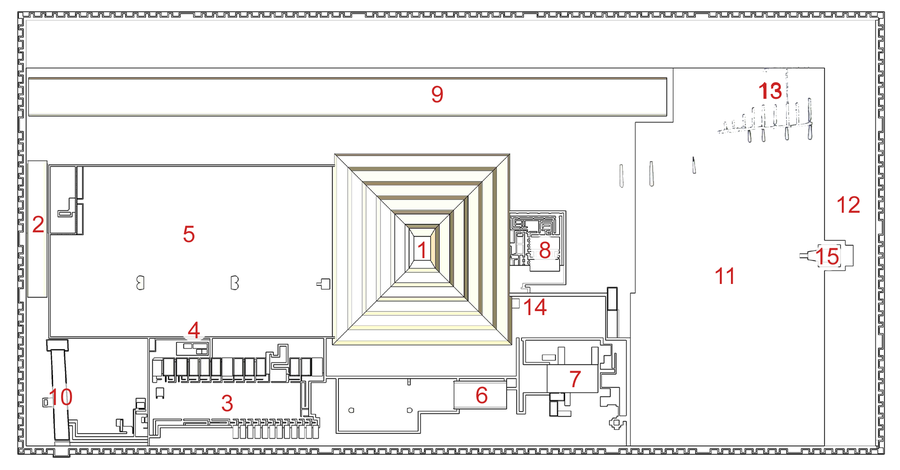
DESIGN LAYOUT
Djoser's mortuary complex comprises the great trench, enclosure wall, colonnaded entrance, 'T' temple, Sed festival complex, north and south pavilions, south tomb and court, western mounds, mortuary temple, and the crowning feature of it all, the step pyramid with its substructure. The complex was a landmark achievement for Egyptian architecture. It was the advent of the pyramidal form of the royal tomb and the first instance of the mass use of limestone in construction, replacing mudbrick which had been the staple building material prior. This shift to limestone – a hard, dense material compared to mudbrick – presented novel challenges to the architects. Though they kept to earlier tradition, copying architectonic elements and carving them into the stone. For example, the Egyptians hand-carved 1,680 9 m (30 ft; 17 cu) tall niches out of the limestone enclosure wall. In earlier projects, this element was built with wooden planks, ropes, and poles hung with reed mats. In a modern context, the same element would be built by laying out the blocks to form the recesses.
STEP PYRAMID
The crowning feature of the complex is the Step Pyramid which rises from the Saqqara plateau in six steps to a height between 60 m (200 ft; 110 cu) and 62.5 m (205 ft; 119.3 cu). This element was revised repeatedly in construction, going through a series of developmental phases that culminated in its step pyramidal form. These phases are traditionally labelled, following Jean-Philippe Lauer's excavations: M1, M2, M3, P1, P1', and P2.
In the early stages (M1 to M3) the structure had the form of a mastaba before alterations (P1 to P2) were made to create its step pyramidal form. In the first stage (M1), the mastaba had a square plan 63 m (207 ft; 120 cu) in length that rose to a height of 8.4 m (28 ft; 16 cu). This was built from a core of limestone blocks arranged in horizontal beds and bound with yellow or red clay. A 2.6 m (9 ft; 5 cu) thick casing of fine white Tura limestone was applied to the core arranged in the same horizontal manner.
The outer blocks were inclined to ~82° and the top of the mastaba likely had a slightly convex shape. A second casing of fine white limestone was applied to this which increased the mastaba's base length to 71.5 m (235 ft; 136 cu) square (M2). The casing was 4.2 m (14 ft; 8 cu) thick at the base and 3.4 m (11 ft; 6.5 cu) thick at the peak, which was 0.65 m (2 ft; 1 cu) lower than the initial mastaba height. The outer blocks of this second coat also had a steeper incline at ~76°. The mastaba was then extended 8.4 m (28 ft; 16 cu) east to cover a series of eleven shafts 33 m (108 ft; 63 cu) deep that ended in passages that led west to the burial chambers of members of Djoser's family. This extension was built from locally sourced limestone rubble and cased by 1.5 m (5 ft; 3 cu) thick limestone coating that formed an extension of M2. The mastaba had a new, rectangular ground plan 71.5 m (235 ft; 136 cu) by 79.5 m (261 ft; 152 cu). At this stage the mastaba still peaked at 8.4 m (28 ft; 16 cu) in height, too short to be seen from outside the 10.5 m (34 ft; 20 cu) high enclosure wall.
Egyptologists are split on the motivations behind the conception of the pyramidal form that the mastaba was converted into. Lauer believed that the alteration was made to have the tomb visible from Memphis. The fact of the mastaba's square plan led Rainer Stadelmann, however, to suggest that it was never the intended final form and that it was planned to be a pyramid from the outset. The conversion (P1) encased the mastaba (M3) extending its length by 5.76 m (19 ft; 11 cu) on each axis giving it a base length of 85.5 m (281 ft; 163 cu) by 77 m (253 ft; 147 cu). The alteration from mastaba to pyramid came with a shift in construction. The builders used larger and better quality, roughly dressed limestone blocks – but instead of horizontal beds, they built successive inclined accretion layers 2–3 m (6.6–9.8 ft) thick. These leaned on each other from opposite ends providing greater stability preventing a collapse.
The whole was then cased in fine white limestone with a layer of packing in between. This phase of the pyramid had four steps that rose to a height of 42 m (138 ft; 80 cu). The decision was then made to expand the pyramid north and west from four to six steps (P1') which was then finished with a final layer of limestone casing (P2) that gave the pyramid its final form. On completion the step pyramid had a base length of 109 m (358 ft; 208 cu) by 121 m (397 ft; 231 cu) that rose to a height of 60–62.5 m (197–205 ft; 115–119 cu) and occupied a volume of 330,400 m3 (11,670,000 cu ft).
Much of the rock for the pyramid was likely quarried from the construction of the great trench. It is widely accepted that ramps would have been used to raise heavy stone to construct the pyramid, and many plausible models have been suggested. For transport, apparatuses like rollers were used in which the heavy stone could be placed and then rolled.
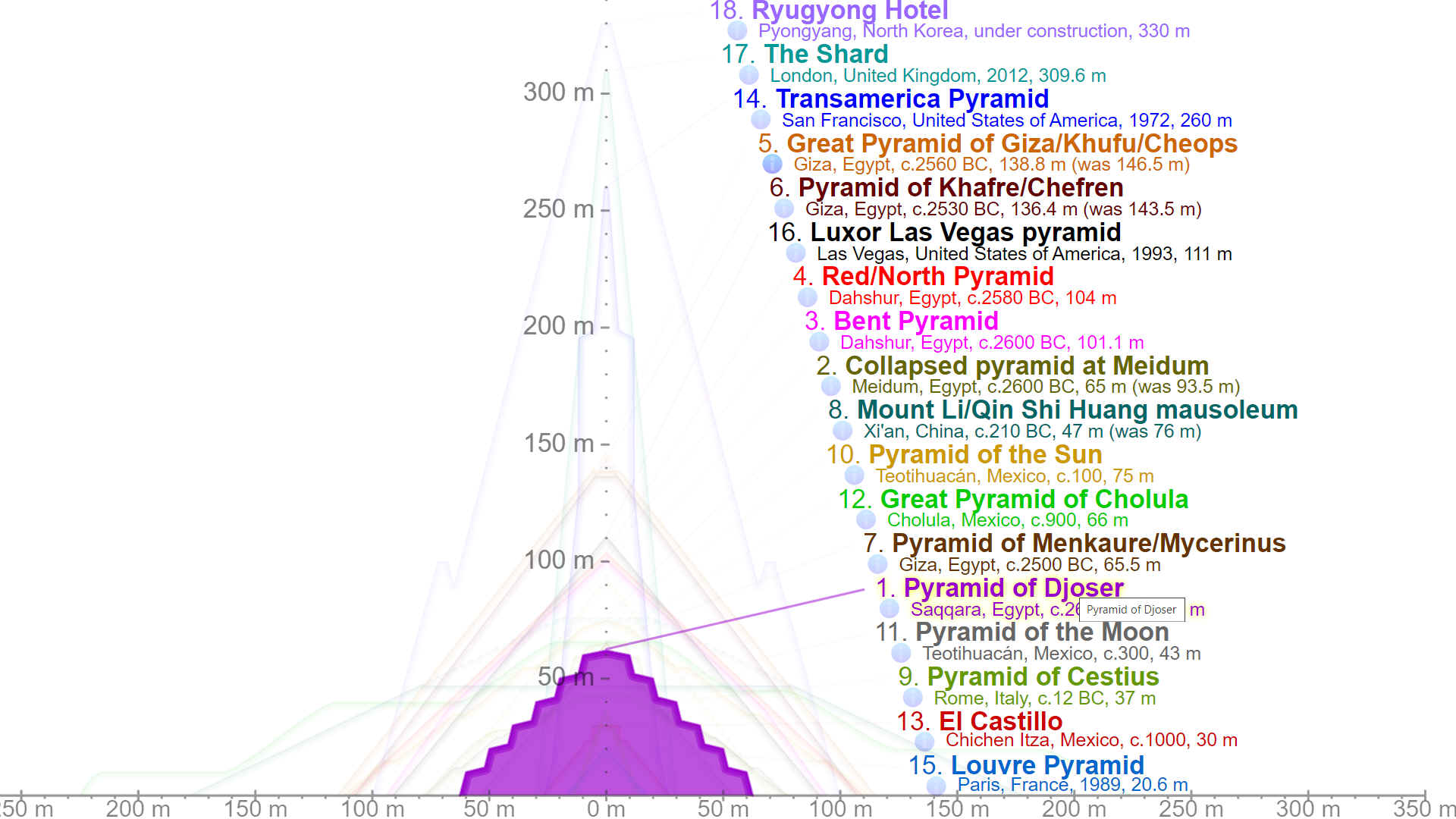
PYRAMID SUBSTRUCTURE
Under the step pyramid is a labyrinth of tunneled chambers and galleries that total nearly 6 km in length and connect to a central shaft 7 m square and 28 m deep. These spaces provide room for the king's burial, the burial of family members, and the storage of goods and offerings. The entrance to the 28 m shaft was built on the north side of the pyramid, a trend that would remain throughout the Old Kingdom. The sides of the underground passages are limestone inlaid with blue faience tile to replicate reed matting. These "palace façade" walls are further decorated by panels decorated in low relief that show the king participating in the Heb-sed. Together these chambers constitute the funerary apartment that mimicked the palace and would serve as the living place of the royal ka. On the east side of the pyramid, eleven shafts 32 m deep were constructed and annexed to horizontal tunnels for royal family members. These were incorporated into the pre-existing substructure as it expanded eastward. In the storerooms along here over 40,000 stone vessels were found, many of which predate Djoser. These would have served Djoser's visceral needs in the afterlife. An extensive network of underground galleries was located to the north, west and south of the central burial chamber and crude horizontal magazines were carved into these.
BURIAL CHAMBER
The burial chamber was a vault constructed of four courses of well-dressed granite. It had one opening, which was sealed with a 3.5 ton block after the burial. No body was recovered as the tomb had been extensively robbed. Lauer believes that a burial chamber of alabaster existed before the one of granite. He found interesting evidence of limestone blocks with five pointed stars in low relief that were likely on the ceiling, indicating the first occurrence of what would become a tradition. The king sought to associate himself with the eternal North Stars that never set so as to ensure his
rebirth and
eternity.
Apart
from ruling their country, the
ancient Egyptians
had time to contemplate how they would cope in the afterlife
during the flooding of the Nile, when farm laborers could be
used to build, giving them a positive agenda. Each
successive ruler of the sandy kingdom, wished for more
comforts, and to outdo their forebears, in terms of how they
would be remembered.
Egypt was one of the richest and most powerful civilizations in the world
at that time. So could afford to convert their national
output, into something tangible, for their citizens to
marvel at. At the time they had few threats to national
security.
Generally,
the bigger the pyramid, the more important the Pharaoh. It's
a Freudian thing. This compendium is in order of height.
There are many very interesting pyramid designs that will be
covered in the general indexing, if they have unusual or
developmental features. Since, the art of pyramid
construction and development appears to have been an ongoing
thing, until it fizzled out as a result of resource scarcities, adventures of thieves, and land grants
to priests, as the last straw that broke the camel’s back.
Pyramids ceased to be economically viable, and a huge drain
on what we'd call the Gross National Product (GNP) today.
And as for climate
change, they are hardly a sustainable practice, in UN
SDG terms.
On
the basis that the
taller the pyramid, the higher the status of the
king or queen,
it might be argued that Khufu takes first prize, with Khafre
a close second. After that, nobody came close to 140 meters,
as the national goal to achieve a taller building than the
last ruler fell by the wayside.
Please
note, this is not a definitive table, but our own guide,
based on freely available information. Students of
archaeology and Egyptologists will draw their own
conclusions. Observations are most welcome, if we have
misquoted anything. We'd be pleased to make corrections as
applicable.

RULER
WITHOUT A PYRAMID - Tragically, queen Cleopatra poisoned herself
with an Egyptian cobra. Later her
mausoleum was washed into the sea by an earthquake and
tsunami in 365AD. Leaving little to visibly remind us of
the great Pharaoh.
The oldest known pyramid in Egypt was built around 2630 B.C. at Saqqara, for the third dynasty’s King Djoser. Known as the Step Pyramid, it began as a traditional mastaba but grew into something much more ambitious. The pyramid’s architect was Imhotep, a priest and healer who some 1,400 years later would be deified as the patron saint of scribes and physicians. Over the course of Djoser’s nearly 20-year reign, pyramid builders assembled six stepped layers of stone (as opposed to mud-brick, like most earlier tombs) that eventually reached a height of 204 feet (62 meters); it was the tallest building of its time. The Step Pyramid was surrounded by a complex of courtyards, temples and shrines where Djoser could enjoy his afterlife.
After Djoser, the stepped pyramid became the norm for royal burials, although none of those planned by his dynastic successors were completed (probably due to their relatively short reigns). The earliest tomb constructed as a “true” (smooth-sided, not stepped) pyramid was the Red Pyramid at Dahshur, one of three burial structures built for the first king of the fourth dynasty, Sneferu (2613-2589 B.C.) It was named for the color of the limestone blocks used to construct the pyramid’s core.
